Jiayi Yuan
Henry
Give Me FP32 or Give Me Death? Challenges and Solutions for Reproducible Reasoning
Jun 11, 2025Abstract:Large Language Models (LLMs) are now integral across various domains and have demonstrated impressive performance. Progress, however, rests on the premise that benchmark scores are both accurate and reproducible. We demonstrate that the reproducibility of LLM performance is fragile: changing system configuration such as evaluation batch size, GPU count, and GPU version can introduce significant difference in the generated responses. This issue is especially pronounced in reasoning models, where minor rounding differences in early tokens can cascade into divergent chains of thought, ultimately affecting accuracy. For instance, under bfloat16 precision with greedy decoding, a reasoning model like DeepSeek-R1-Distill-Qwen-7B can exhibit up to 9% variation in accuracy and 9,000 tokens difference in response length due to differences in GPU count, type, and evaluation batch size. We trace the root cause of this variability to the non-associative nature of floating-point arithmetic under limited numerical precision. This work presents the first systematic investigation into how numerical precision affects reproducibility in LLM inference. Through carefully controlled experiments across various hardware, software, and precision settings, we quantify when and how model outputs diverge. Our analysis reveals that floating-point precision -- while critical for reproducibility -- is often neglected in evaluation practices. Inspired by this, we develop a lightweight inference pipeline, dubbed LayerCast, that stores weights in 16-bit precision but performs all computations in FP32, balancing memory efficiency with numerical stability. Code is available at https://github.com/nanomaoli/llm_reproducibility.
AutoL2S: Auto Long-Short Reasoning for Efficient Large Language Models
May 28, 2025Abstract:The reasoning-capable large language models (LLMs) demonstrate strong performance on complex reasoning tasks but often suffer from overthinking, generating unnecessarily long chain-of-thought (CoT) reasoning paths for easy reasoning questions, thereby increasing inference cost and latency. Recent approaches attempt to address this challenge by manually deciding when to apply long or short reasoning. However, they lack the flexibility to adapt CoT length dynamically based on question complexity. In this paper, we propose Auto Long-Short Reasoning (AutoL2S), a dynamic and model-agnostic framework that enables LLMs to dynamically compress their generated reasoning path based on the complexity of the reasoning question. AutoL2S enables a learned paradigm, in which LLMs themselves can decide when longer reasoning is necessary and when shorter reasoning suffices, by training on data annotated with our proposed method, which includes both long and short CoT paths and a special <EASY> token. We then use <EASY> token to indicate when the model can skip generating lengthy CoT reasoning. This proposed annotation strategy can enhance the LLMs' ability to generate shorter CoT reasoning paths with improved quality after training. Extensive evaluation results show that AutoL2S reduces the length of reasoning generation by up to 57% without compromising performance, demonstrating the effectiveness of AutoL2S for scalable and efficient LLM reasoning.
Stop Overthinking: A Survey on Efficient Reasoning for Large Language Models
Mar 20, 2025Abstract:Large Language Models (LLMs) have demonstrated remarkable capabilities in complex tasks. Recent advancements in Large Reasoning Models (LRMs), such as OpenAI o1 and DeepSeek-R1, have further improved performance in System-2 reasoning domains like mathematics and programming by harnessing supervised fine-tuning (SFT) and reinforcement learning (RL) techniques to enhance the Chain-of-Thought (CoT) reasoning. However, while longer CoT reasoning sequences improve performance, they also introduce significant computational overhead due to verbose and redundant outputs, known as the "overthinking phenomenon". In this paper, we provide the first structured survey to systematically investigate and explore the current progress toward achieving efficient reasoning in LLMs. Overall, relying on the inherent mechanism of LLMs, we categorize existing works into several key directions: (1) model-based efficient reasoning, which considers optimizing full-length reasoning models into more concise reasoning models or directly training efficient reasoning models; (2) reasoning output-based efficient reasoning, which aims to dynamically reduce reasoning steps and length during inference; (3) input prompts-based efficient reasoning, which seeks to enhance reasoning efficiency based on input prompt properties such as difficulty or length control. Additionally, we introduce the use of efficient data for training reasoning models, explore the reasoning capabilities of small language models, and discuss evaluation methods and benchmarking.
Interpreting and Steering LLMs with Mutual Information-based Explanations on Sparse Autoencoders
Feb 21, 2025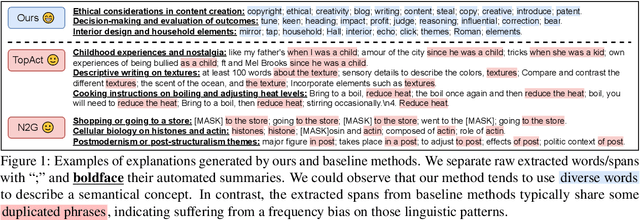
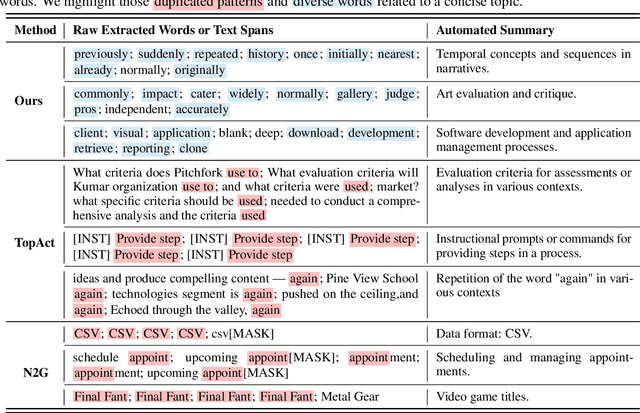
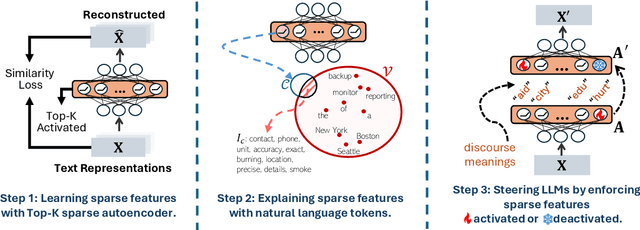
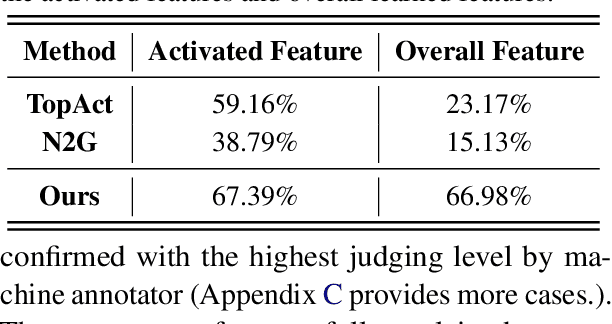
Abstract:Large language models (LLMs) excel at handling human queries, but they can occasionally generate flawed or unexpected responses. Understanding their internal states is crucial for understanding their successes, diagnosing their failures, and refining their capabilities. Although sparse autoencoders (SAEs) have shown promise for interpreting LLM internal representations, limited research has explored how to better explain SAE features, i.e., understanding the semantic meaning of features learned by SAE. Our theoretical analysis reveals that existing explanation methods suffer from the frequency bias issue, where they emphasize linguistic patterns over semantic concepts, while the latter is more critical to steer LLM behaviors. To address this, we propose using a fixed vocabulary set for feature interpretations and designing a mutual information-based objective, aiming to better capture the semantic meaning behind these features. We further propose two runtime steering strategies that adjust the learned feature activations based on their corresponding explanations. Empirical results show that, compared to baselines, our method provides more discourse-level explanations and effectively steers LLM behaviors to defend against jailbreak attacks. These findings highlight the value of explanations for steering LLM behaviors in downstream applications. We will release our code and data once accepted.
Robot Learning with Super-Linear Scaling
Dec 02, 2024Abstract:Scaling robot learning requires data collection pipelines that scale favorably with human effort. In this work, we propose Crowdsourcing and Amortizing Human Effort for Real-to-Sim-to-Real(CASHER), a pipeline for scaling up data collection and learning in simulation where the performance scales superlinearly with human effort. The key idea is to crowdsource digital twins of real-world scenes using 3D reconstruction and collect large-scale data in simulation, rather than the real-world. Data collection in simulation is initially driven by RL, bootstrapped with human demonstrations. As the training of a generalist policy progresses across environments, its generalization capabilities can be used to replace human effort with model generated demonstrations. This results in a pipeline where behavioral data is collected in simulation with continually reducing human effort. We show that CASHER demonstrates zero-shot and few-shot scaling laws on three real-world tasks across diverse scenarios. We show that CASHER enables fine-tuning of pre-trained policies to a target scenario using a video scan without any additional human effort. See our project website: https://casher-robot-learning.github.io/CASHER/
InvestESG: A multi-agent reinforcement learning benchmark for studying climate investment as a social dilemma
Nov 15, 2024



Abstract:InvestESG is a novel multi-agent reinforcement learning (MARL) benchmark designed to study the impact of Environmental, Social, and Governance (ESG) disclosure mandates on corporate climate investments. Supported by both PyTorch and GPU-accelerated JAX framework, the benchmark models an intertemporal social dilemma where companies balance short-term profit losses from climate mitigation efforts and long-term benefits from reducing climate risk, while ESG-conscious investors attempt to influence corporate behavior through their investment decisions. Companies allocate capital across mitigation, greenwashing, and resilience, with varying strategies influencing climate outcomes and investor preferences. Our experiments show that without ESG-conscious investors with sufficient capital, corporate mitigation efforts remain limited under the disclosure mandate. However, when a critical mass of investors prioritizes ESG, corporate cooperation increases, which in turn reduces climate risks and enhances long-term financial stability. Additionally, providing more information about global climate risks encourages companies to invest more in mitigation, even without investor involvement. Our findings align with empirical research using real-world data, highlighting MARL's potential to inform policy by providing insights into large-scale socio-economic challenges through efficient testing of alternative policy and market designs.
Taylor Unswift: Secured Weight Release for Large Language Models via Taylor Expansion
Oct 06, 2024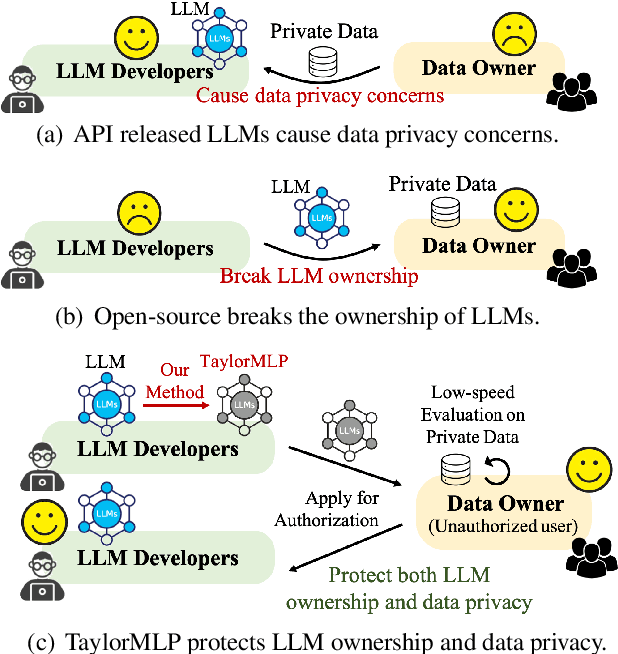
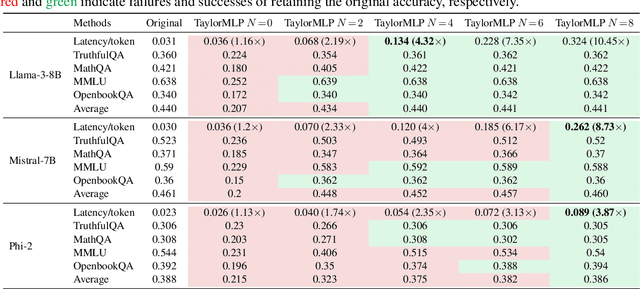
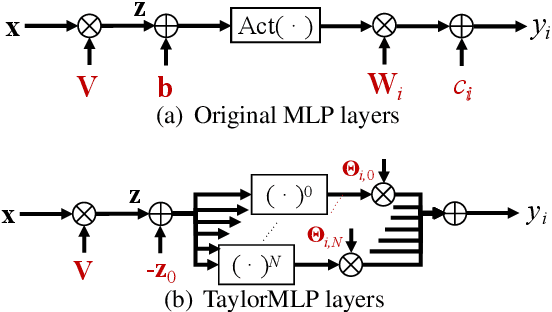
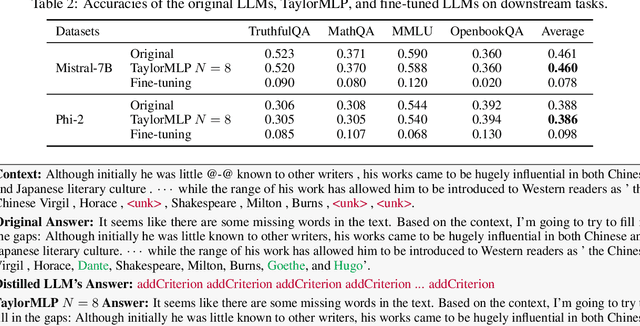
Abstract:Ensuring the security of released large language models (LLMs) poses a significant dilemma, as existing mechanisms either compromise ownership rights or raise data privacy concerns. To address this dilemma, we introduce TaylorMLP to protect the ownership of released LLMs and prevent their abuse. Specifically, TaylorMLP preserves the ownership of LLMs by transforming the weights of LLMs into parameters of Taylor-series. Instead of releasing the original weights, developers can release the Taylor-series parameters with users, thereby ensuring the security of LLMs. Moreover, TaylorMLP can prevent abuse of LLMs by adjusting the generation speed. It can induce low-speed token generation for the protected LLMs by increasing the terms in the Taylor-series. This intentional delay helps LLM developers prevent potential large-scale unauthorized uses of their models. Empirical experiments across five datasets and three LLM architectures demonstrate that TaylorMLP induces over 4x increase in latency, producing the tokens precisely matched with original LLMs. Subsequent defensive experiments further confirm that TaylorMLP effectively prevents users from reconstructing the weight values based on downstream datasets.
DHP Benchmark: Are LLMs Good NLG Evaluators?
Aug 25, 2024Abstract:Large Language Models (LLMs) are increasingly serving as evaluators in Natural Language Generation (NLG) tasks. However, the capabilities of LLMs in scoring NLG quality remain inadequately explored. Current studies depend on human assessments and simple metrics that fail to capture the discernment of LLMs across diverse NLG tasks. To address this gap, we propose the Discernment of Hierarchical Perturbation (DHP) benchmarking framework, which provides quantitative discernment scores for LLMs utilizing hierarchically perturbed text data and statistical tests to measure the NLG evaluation capabilities of LLMs systematically. We have re-established six evaluation datasets for this benchmark, covering four NLG tasks: Summarization, Story Completion, Question Answering, and Translation. Our comprehensive benchmarking of five major LLM series provides critical insight into their strengths and limitations as NLG evaluators.
KV Cache Compression, But What Must We Give in Return? A Comprehensive Benchmark of Long Context Capable Approaches
Jul 01, 2024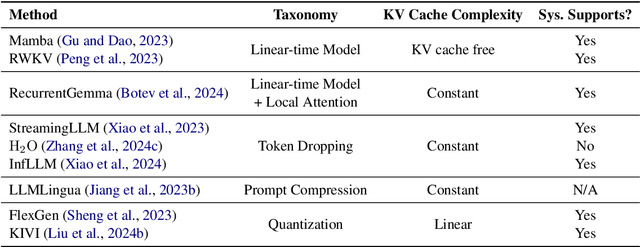


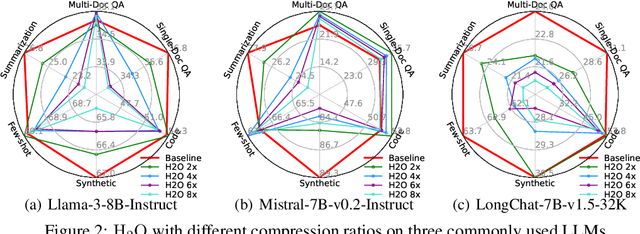
Abstract:Long context capability is a crucial competency for large language models (LLMs) as it mitigates the human struggle to digest long-form texts. This capability enables complex task-solving scenarios such as book summarization, code assistance, and many more tasks that are traditionally manpower-intensive. However, transformer-based LLMs face significant challenges with long context input due to the growing size of the KV cache and the intrinsic complexity of attending to extended inputs; where multiple schools of efficiency-driven approaches -- such as KV cache quantization, token dropping, prompt compression, linear-time sequence models, and hybrid architectures -- have been proposed to produce efficient yet long context-capable models. Despite these advancements, no existing work has comprehensively benchmarked these methods in a reasonably aligned environment. In this work, we fill this gap by providing a taxonomy of current methods and evaluating 10+ state-of-the-art approaches across seven categories of long context tasks. Our work reveals numerous previously unknown phenomena and offers insights -- as well as a friendly workbench -- for the future development of long context-capable LLMs. The source code will be available at https://github.com/henryzhongsc/longctx_bench
Understanding Different Design Choices in Training Large Time Series Models
Jun 20, 2024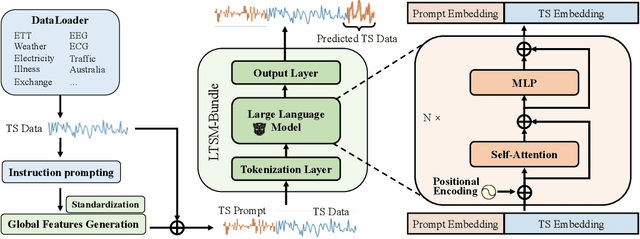


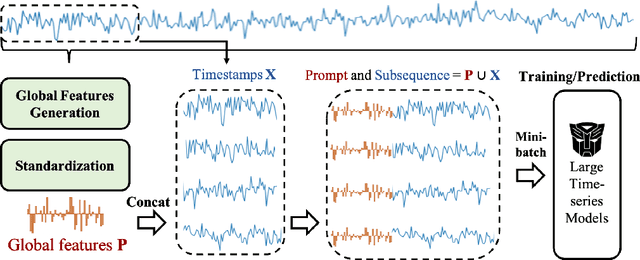
Abstract:Inspired by Large Language Models (LLMs), Time Series Forecasting (TSF), a long-standing task in time series analysis, is undergoing a transition towards Large Time Series Models (LTSMs), aiming to train universal transformer-based models for TSF. However, training LTSMs on heterogeneous time series data poses unique challenges, including diverse frequencies, dimensions, and patterns across datasets. Recent endeavors have studied and evaluated various design choices aimed at enhancing LTSM training and generalization capabilities, spanning pre-processing techniques, model configurations, and dataset configurations. In this work, we comprehensively analyze these design choices and aim to identify the best practices for training LTSM. Moreover, we propose \emph{time series prompt}, a novel statistical prompting strategy tailored to time series data. Furthermore, based on the observations in our analysis, we introduce \texttt{LTSM-bundle}, which bundles the best design choices we have identified. Empirical results demonstrate that \texttt{LTSM-bundle} achieves superior zero-shot and few-shot performances compared to state-of-the-art LSTMs and traditional TSF methods on benchmark datasets.
 Add to Chrome
Add to Chrome Add to Firefox
Add to Firefox Add to Edge
Add to Edge